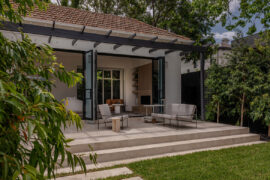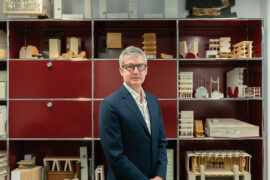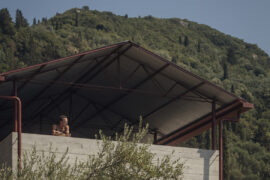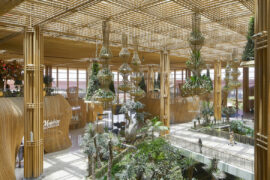This Tin Sheds Gallery exhibition delves into complexity and contradiction in the Hunter Region in the context of coal and climate crisis.

Jennifer Ferng and Daniel Ryan.
November 13th, 2024
Set within the School of Architecture, Design and Planning at the University of Sydney, Tin Sheds Gallery has a proud history of protest-driven and socially engaged exhibitions. The latest, Monumental Imaginaries, focuses on the coal of the Hunter Region in New South Wales. In particular, it showcases the intersections of visual culture and questions of energy transition – from political art to architectural drawings and sculptures.
The exhibition is presented with the support of the Sydney Environment Institute, Arts and Humanities Research Council UK, Powerhouse Museum, Mogu, Surfrider Foundation, Tony Song (Boral), the University of Newcastle and the Volpato family. Daniel Ryan co-curated it alongside Jennifer Ferng, and he explains the overall focus: “We’re keen to get out of simply looking at energy transition in terms of architecture to include how different disciplines look at it, but also to explore that there is a visual culture of energy transition too.”

Organised into multiple parts, the show features multimedia works including video projections, photography, drawings, sculptures and more, all arranged around a focal point that makes a poignant historical reference. ‘Hewing. Shipping.’ by Luke Ryan O’Connor is set in a central space to be seen in the round, acting as a point of reimagination in relation to Newcastle’s Jubilee Coal Monument – a monument built 115 years ago by a City of Newcastle enthralled by coal.
“We thought it would be provocative to focus the show around the monument because of its contradictions,” adds Ryan.
Related: Replica Autoprogettazione at Tin Sheds

By embedding questions of energy transition and fossil fuel damage in a specific place, the exhibition adds a human dimension to questions that can obviously be read on a global scale of crisis. The attachment of this city and region to coal is seen in its historical context, one in which the industry at one time represented righteous labour struggles and industrial action more than climate change. “There can be a tendency to talk about energy transition as if the lives of people who work there don’t matter,” notes Ryan, a prompt to remind visitors that urgent climate justice also urgently requires justice for workers in such areas.
Monumental Imaginaries takes us first to questions of fossil fuel legacies. Merilyn Fairskye in ‘Yesterday New Future (Liddell)’ (on loan from the Powerhouse Museum) captures the transition of the Liddell Power Station in the Hunter Valley, considering the site as a microcosm of geological time, human settlement and industrial transformation.

“Academics often discuss energy transition purely in technical terms,” says Ryan. “Yet, at the same time, there exists a culture of protest enabling energy transition, so we were keen to highlight some of the imagery around that.” The visual culture focus also allows for a sense of imagining different futures, “a kind of ‘climate imaginary’ based on sustainable lifestyles,” as Ryan adds.
One important aim of the exhibition is to depict the scale of the fossil legacy, whether that means looking at the mines themselves or the power centres. It was then “to highlight some of the culture of protest that comes with it, and the shifting sensibility in the area about future architecture,” explains Ryan.

Other areas set out in the gallery concentrate on themes of community, counter-monuments and emerging programs. Architectural pieces are presented from practices including Prevalent and Collins and Turner Architects, while the 1966 Munmorah Power Station Mural by Italian-born architect Gino Volpato is on show in digital form, having been carefully scanned and dismantled in 2017 before becoming part of the Powerhouse collection.
Monumental Imaginaries is at Tin Sheds Gallery, Sydney from 10th October to 15th November.
Tin Sheds Gallery
sydney.edu.au
Photography
Maja Baska Photography courtesy of Tin Sheds Gallery













Read about a previous exhibition on radio and protest culture here
INDESIGN is on instagram
Follow @indesignlive
A searchable and comprehensive guide for specifying leading products and their suppliers
Keep up to date with the latest and greatest from our industry BFF's!

For Aidan Mawhinney, the secret ingredient to Living Edge’s success “comes down to people, product and place.” As the brand celebrates a significant 25-year milestone, it’s that commitment to authentic, sustainable design – and the people behind it all – that continues to anchor its legacy.

Welcomed to the Australian design scene in 2024, Kokuyo is set to redefine collaboration, bringing its unique blend of colour and function to individuals and corporations, designed to be used Any Way!

Through experience and with a passion for great design, Biasol is making gentle and perfect waves on the landscape of design.

Leading by design, Erik L’Heureux has recently taken the helm of Monash University’s Department of Architecture, and so a new and exciting journey begins for both L’Heureux and the University.
The internet never sleeps! Here's the stuff you might have missed

A star of the 2025 INDE Awards is Jenchieh Hung + Kulthida Songkittipakdee / HAS design and research, a practice that made quite the impression on the jury and in the awards.

Dr Piers Taylor – award-winning British architect, BBC presenter and founder of Invisible Studio – returns to Australia to deliver a keynote at the inaugural Glenn Murcutt Symposium.

The independent Master Jury of the 16th Award Cycle (2023-2025) has selected seven winning projects from China to Palestine.

Winner of the INDE.Awards 2025 Best of the Best, Terminal 2 Kempegowda International Airport Interiors by Enter Projects Asia and SOM showcases 12,000-square-metres of biophilic design, featuring nine kilometres of handwoven rattan in a sustainable, world-class passenger experience.